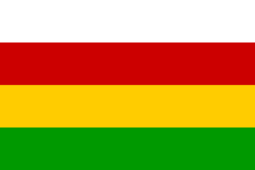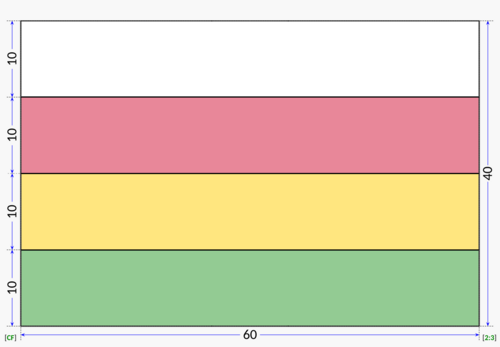Flag of Batsweda
 | |
| Name | Sahrabic: علم البهودة |
|---|---|
| Use | National flag and ensign |
| Proportion | 2:3 |
| Adopted | December 24, 1960 |
| Design | Four horizontal stripes of white, red, yellow and green. |
| Designed by | Elizabeth Donkor |
The national flag of Batsweda (Sahrabic: علم البهودة, Eaʿlam āl-Bahūda) consists of four stripes of white, red, yellow and green arranged horizontally. First adopted in 1960 after the country's independence from the Pepper Coast Company, the design has remained consistent under four constitutions and three civil conflicts.
Design
The flag of Batsweda is a field divided into four equal horizontal bands of white, red, yellow, and green. According to the first constitution of the People's Republic of Batsweda, the colours represent peace (white), socialist revolution (red), prosperity (yellow), and progress (green). Later descriptions of the colour red have replaced the original meaning with that of sacrifice, with this interpretation has been popularized since the First Batswedan Civil War in the late 1960s.
Construction
Proportions and colours
The official proportions of the flag of Batsweda, in accordance with the country's first constitution, is 2:3. The flag's colours are also defined in the constitution, and confirmed with hexadecimal values in the 2005 Digital National Symbols Act, intended for the flag's use on the Internet and digital media.

|
White | Red | Yellow | Green |
|---|---|---|---|---|
| RGB | 255/255/255 |
204/0/0 |
255/204/0 |
0/153/0
|
| Hexadecimal | #FFFFFF |
#CC0000 |
#FFCC00 |
#009900
|
| CMYK | 0/0/0/0 |
0/100/100/20 |
0/20/100/0 |
100/0/100/40
|
| Pantone | White | 186 C | Yellow C | 7739 C |
History
The first attested flag used in a modern fashion in present-day Batsweda was the banner of the Sarafid Empire during the Early Middle Ages, during the Empire's rule over the region. Early flags commonly often denoted ruling dynasties and authorities, and originated from Yienite entities to Batsweda's south. Native ethnic groups in the area, particularly the Banno, did not use flags in identifying control of land and authority until the Late Middle Ages, but used markings, steles, and other alternative symbols in denoting authority. The first flag of a unified Batswedan entity stems from the personal standard of Kã́á (king) Nsĩã́ of the Batswedan Empire, used around 1550. The banner, depicting a yellow palm tree on a green field, was used to sporadically denote Batswedan authority up until the 17th century.
With the annexation of the Batswedan Empire by the Pepper Coast Company in 1811, colonial authorities adopted a white flag charged with the logo of the PCC to represent the colony of the Pepper Coast, primarily Company holdings and property. A civil flag, consisting of a red-yellow-and-green tricolour with the badge of the Pepper Coast in the centre, was adopted in 1917 to specifically represent the colonial administration, and was used concurrently with the commonly-named "company flag".
During the Batswedan War of Independence, supporters of the Batswedan Popular Front defaced the civil flag by painting over the colony's badge with white paint, creating a tricolour with a blank white circle. This flag, often referred to as the "Independence Flag", was quickly adopted by the BPF during the war, and after Batsweda's declaration of independence on 11 November 1960, this flag was temporarily adopted by the new government until a new design could be selected and approved by Parliament after a competition.
Elizabeth Donkor, a 51-year old Mi seamstress, placed her design of a flag of four horizontal stripes of white, red, yellow, and green in the national competition in late November 1960. The design quickly became the favourite option of Prime Minister Joseph Baa and his cabinet, and was officially approved as the new flag on December 24 1960 by an Act of Parliament. Since its adoption, the design has remained unchanged throughout Batsweda's history as an independent nation, and enshrined in four constitutions.
Historical flags
| Flag | Years of use | Ratio | Government | Description |
|---|---|---|---|---|
| 416–756 | N/A | As part of the Sarafid Empire | A green field with a lion and sun in the centre. | |

|
c. 1550 | N/A | Batswedan Empire | A green field with a yellow palm tree in the centre. |

|
1824–1960 | 2:3 | Pepper Coast | A white field with the logo of the Pepper Coast Company in the centre. |

|
1917–1960 | 2:3 | A vertical tricolour of red, yellow, and green with the badge of the Pepper Coast in the centre stripe. | |

|
1960–1960 | 2:3 | People's Republic of Batsweda | A vertical tricolour of red, yellow, and green with a white circle in the centre stripe. Used unofficially. |

|
1960–present | 2:3 | Four horizontal stripes of white, red, yellow and green. | |
| Republic of Batsweda | ||||
| Kingdom of Batsweda | ||||
| Republic of Batsweda |
